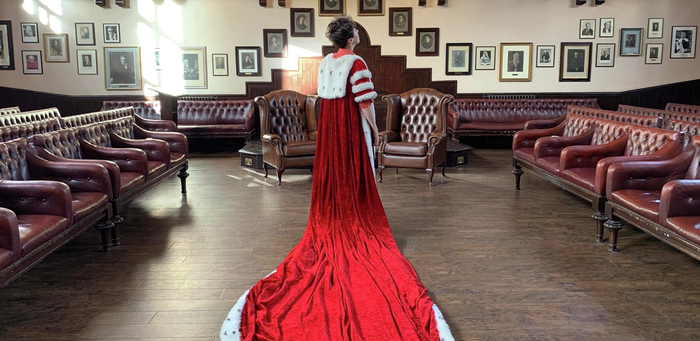It is in the bells I hear my voices: Saint Joan
Saint Joan stuns at the Cambridge Union

The lights go down, plunging the Union Chamber into darkness as the audience falls silent. And then, one by one, the bells toll as they usher Joan – and the play – forward to her fate.
Saint Joan, adapted from the play by George Bernard Shaw and directed by Tom Runciman, recounts the rise and fall of Joan of Arc from her entry into the Dauphin’s army, to her success at Orléans, to her trial and execution. The play itself was written only 3 years after the Catholic Church reversed their stance on Joan of Arc and canonised her. The production team have made what I feel was the correct choice to present a stripped back version of the play, shortening the overall run time by close to an hour and, in the words of their director, ‘but [with] lots (and lots!) of monologues removed’.
“Forces the audience into culpability as they do gaze upon the trial”
It is being staged in the Cambridge Union debating chamber – only the second to do so, following last semester’s The Merchant of Venice. The play makes beautiful use of the space, with a stripped back set design that both makes the play feel more intimate and forces the audience into culpability as they do gaze upon the trial but make no move to intervene on Joan’s behalf. The lighting is also a delight, alternately shining a spotlight upon the actors in the centre of the stage like an accusation or plunging the room into total darkness with each transition. The trial scene was expertly staged, with Joan’s three ‘judges’ staring down at her from the raised dais while she sits alone, forced to stare not just at them but also at the blinding lights that illuminate the chamber.
The live music and the costumes (hired from the National Theatre) also contributed to the immersion into fifteenth-century France. I especially loved the tubular bells which chimed through each scene change and contributed not only to the sense of passing time (as each of the scenes take place some months or years apart) but also allowed us to hear a bit of what Joan does. Her call to destiny.
“It deftly explores the themes of a society that is able to rationalise a tragedy so long as that sacrifice brings them political gain”
The play itself runs the gamut from farce to tragedy – a special mention here to Jack Hawkins who was perhaps in part responsible for stripped back set due to his marvellous habit of chewing on all he scenery he could find – though it does retain some darkly humorous elements in its later scenes. There is a little tonal whiplash as the play moves from comedy to tragedy, but this is smoothed over by the very competent cast, who throw themselves wholeheartedly into their roles to great success.
A play named Saint Joan lives or dies on its eponymous character and Marie-Ange Camara does not disappoint, bringing what can only be described as a ‘stubborn innocence’ to her character who stands firm to her beliefs despite the consequences it brings. Camara portrays Joan as something ‘other’, someone who despite (or because) of the benefits that she’s brought to the French court nonetheless provokes disquiet in the upper echelons of the court.
Saint Joan feels like a very modern play as it deftly explores the themes of a society that is able to rationalise a tragedy so long as that sacrifice brings them political gain. None of the characters see themselves as unrepentantly evil, even as their send a young girl off to her painful death. Each of them dramatic, ridiculous, and emotional in turn, Saint Joan takes full advantage of the intimate theatre space to deliver a play shouldn’t still be as relevant, nearly a hundred years after it was written.
Saint Joan is showing at 7:30 pm in the Cambridge Union Debating Chamber from Sat 14th – Sun 15th May
 Music / The pipes are calling: the life of a Cambridge Organ Scholar25 April 2025
Music / The pipes are calling: the life of a Cambridge Organ Scholar25 April 2025 News / Candidates clash over Chancellorship25 April 2025
News / Candidates clash over Chancellorship25 April 2025 Interviews / Dr Ally Louks on going viral for all the wrong reasons25 April 2025
Interviews / Dr Ally Louks on going viral for all the wrong reasons25 April 2025 Comment / Cambridge builds up the housing crisis25 April 2025
Comment / Cambridge builds up the housing crisis25 April 2025 Arts / Plays and playing truant: Stephen Fry’s Cambridge25 April 2025
Arts / Plays and playing truant: Stephen Fry’s Cambridge25 April 2025






